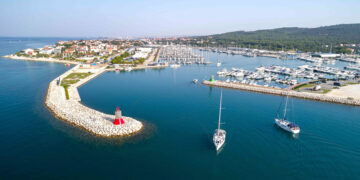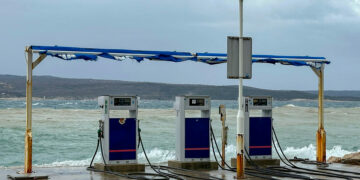The right maritime reading material must be on board, and not just for the long-awaited vacation cruise. Especially in the winter season, water sports enthusiasts are happy to continue to be at sea, at least in their thoughts. The selection of maritime literature is large, the pallet reaches from sometimes unintentional comedy with trip reports with sail novices over gripping biographies and adventure stories up to maritime classics. SeaHelp presents ten books that belong in every good library.
Reading Tip 1:
Dana Sobel “Longitude“
Dana Sobel takes us back to the days before electronic maps, GPS and radar surveillance with her novel Longitude. It’s a tribute to master watchmaker John Harrison, who made it possible to determine longitude accurately with a specially constructed clock. Today we can no longer imagine that the problem of exact east-west positioning was so urgent in the 17th century that the English king offered an enormous sum of money for the scientific solution. A book that will delight not only chief navigators and give us all a little tutoring in the basics of astronavigation.
ISBN: 978-3-49240-530-0
Reading Tip 2:
Sten Nadolny “The Discovery of Slowness“
Perfect for decelerating cruising speed under sail or on a leisurely touring ship is Sten Nadolny’s novel “The Discovery of Slowness.” Superficially, it is about the biography of the English navigator and North Pole explorer John Franklin, who pursues the dream of discovering the Northwest Passage across the Arctic pack ice. Nadolny’s protagonist is not a hero in the classic sense – he thinks, speaks and reacts considerably more slowly than his fellow men. But everything he has once grasped and grasped, he retains better than others. With an atlas at his side, the explorer’s journeys to Tasmania, the Cape of Good Hope, and the Eternal Ice are easy to follow.
ISBN: 978-3-49220-700-3
Reading Tip 3:
Erskine Childers “The Riddle of the Sandbar“
“The Riddle of the Sandbar,” this superb spy thriller under sail by Erskine Childers, set in the East Frisian Wadden Sea, is a real must-read. Written as early as 1903 under the impression of the naval arms race between England and the German Empire, Childers’ message that there was a possibility of an invasion of England by German naval forces was so forceful that naval bases were established off Essex while Churchill was still in power. Whereas the two protagonists of the story are primarily concerned with secretly mapping the East Frisian tidal flats for England. While reading, one can literally smell the silt, hear the gurgling of the tidewater, and try not to disturb the whispering between the sandbanks by turning the pages too hastily.
ISBN: 978-3-25720-211-3
Reading Tip 4:
Alfred Andersch “Sansibar or the Last Reason“
The book offers much more than a story about sailing, the sea and the harsh forces of nature. In the milieu of coastal fishermen in the small Baltic Sea hamlet of Rerik, the political story begins, ending with a clear message to readers and a clandestine departure across the wintry Baltic Sea. The story tells of the joint escape of opponents of the regime from the “Third Reich” on the ship of the fisherman Knudsen across the Baltic Sea. Along for the ride: a wooden sculpture that can be interpreted as the work of Ernst Barlach. And the still uninformed fisherman boy who, regardless of the political threat, has only the desire to simply sail away across the sea. His experiences reveal a second, dreamlike narrative level. Exciting, mysterious and challenging to read!
ISBN: 978-3-25723-601-9
Reading Tip 5:
Scot Huler “The Language of the Wind“
A wonderful foray into the history of seafaring and science!
Turning science into poetry worth reading is what author Scott Huler, who originally worked as an editor for a publishing company, excels at. It’s a gift he unleashes the moment he stumbles across the Beaufort scale in his dictionary. He is fascinated by the linguistic beauty of the scale, which can describe the twelve different strengths of the wind in just 110 words. Sparked by this enthusiasm for wind, Scott Huler sets out on a literary journey across land and sea through the centuries. Not only does Francis Beaufort get his due, but also Daniel Defoe, Charles Darwin, and the legendary captains Bligh and Cook.
ISBN: 978-3-86648-202-9
Reading Tip 6:
Marc Bielefeldt “Who has sea, needs less“
Probably the most haunting and best book that is simply about sailing and the sometimes purist life on board. Yet the title is wisely chosen, for those who have learned to go to sea, to accept the sea as it is and surrender to the pace set by the wind, have more. More sensations for the beauty of nature. More sensations for the loneliness at sea, the silence at night, interrupted only by the lapping of the waves against the ship’s side.
Author Marc Bielefeld has experienced this more for himself. On a small ship. Not a floating luxury apartment, but a very normal wooden sailboat. Without refrigerator, television, air conditioning and W-Lan. A ship with a soul. Without (superfluous) comfort. Here the author takes his time out from everyday life. Decelerates. Takes more than one gear out of gear. Takes us into a world that is good for us.
ISBN: 978-3-453-60467-4
Reading Tip 7:
Isabelle Autissier “Heart on Ice“
A story like an icy maelstrom that you can’t put down. Written by Isabelle Autissier, one of the best sailors in the world. In 1991 she became the first woman to sail solo around the world, and now she writes bestsellers.
The book’s plot begins innocuously: young Parisian couple Louise and Ludovic decide to take a sabbatical together and plan to sail around the world. But during a climbing excursion on an uninhabited island off Cape Horn, they are caught in a severe storm. Afterwards, their yacht is gone and with it, along with food and clothing, any means of communication to alert others to their predicament. An existential struggle against hunger and cold ensues, revealing previously unknown character traits in the protagonists. Above all, there is the crucial question: What becomes of love when survival is at stake?
ISBN: 978-3-86648-256-2
Reading Tip 8:
Boris Herrmann “Alone between Sky and Sea“
This superbly edited account of Boris Herrmann’s successful participation in the Vendée Globe, the nonstop around-the-world regatta for solo sailors, is more than just a book for racing enthusiasts. Boris Herrmann describes the emotional highs and lows during his 80 days alone at sea. He recounts the natural beauty and encounters with sea creatures and albatrosses, and vividly recalls the toughest moments of yacht racing. Even though you know the story ended well, his recollections of the dramatic rescue operation in the Southern Ocean for a shipwrecked competitor read so thrillingly that you tremble for the shipwrecked man’s life as you read.
Boris Herrmann himself says of his book: “This book is an invitation to come on board and experience this race around the world once again, with all my impressions and emotions. And it is also an inspiration. It’s worth trying everything to make a lifelong dream come true. The hurdles are high, the risks numerous. But the greatest risk would be not to try.”
ISBN: 978-3-570-10454-5
Reading Tip 9:
Joseph Conrad “Shadowline“
“Lord Jim”, “Mirror of the Sea” or even “Shadow Line” – if you love the sea and great literature, you can’t avoid the British author Joseph Conrad. Yet the novel “Shadow Line” is the only one told from the first-person perspective by Conrad, who himself went to sea on merchant ships for many years. The plot: a shipmaster is urgently needed in the port metropolis of Bangkok, because the three-masted barque lying at anchor is to quickly transport its cheap cargo to Singapore. A job offer that the young, inexperienced skipper is only too happy to accept.
A distance of 800 nautical miles can actually be covered in less than ten days. But the ship gets caught in a heavy storm and the captain has to make quick decisions to save crew and ship. He has thus arrived at a borderline in his life, the line at which it is necessary to leave behind the cheerful, carefree days of youth and take on responsibility. This is the perfect literary companion for anyone who wants to be more than just an occasional fellow sailor, and who now wants to take the helm himself and be confident in seamanship and ship management.
ISBN: 978-3-446-25456-5
Reading Tip 10:
Jan von der Bank: “The Color of the Sea“
Starboat World Championship 1939 off Kiel. The young sailmaker Ole Storm is a forescoter with Rear Admiral Paul von Wellersdorf. The latter notices an unusual talent in his young Scot: he can interpret the colors of the waves and the sea, his view of the sea tells him where the current is particularly strong and when the tide is particularly violent. A year later, the admiral takes the fisherman’s son with him on the “Skagerrak,” a navy sailing yacht on a secret mission to Scandinavia. Between the rocky ledges of the archipelago, Ole finds himself in a highly dangerous espionage case and gets caught between the fronts of the Gestapo and the German resistance.
This gripping sailing thriller by Jan von der Bank, himself a former world champion in the Contender and author of numerous television thrillers, is not stingy with suspense and apt descriptions of the scenery at sea. An exciting historical thriller with a pleasant sailing and nautical expertise.
ISBN: 978-3-94546-536-3













